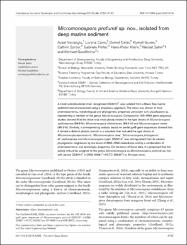| dc.contributor.author | Veyisoğlu, Ayşel | |
| dc.contributor.author | Carro, Lorena | |
| dc.contributor.author | Çetin, Demet | |
| dc.contributor.author | Güven, Kıymet | |
| dc.contributor.author | Sproeer, Cathrin | |
| dc.contributor.author | Poetter, Gabriele | |
| dc.contributor.author | Goodfellow, Michael | |
| dc.date.accessioned | 2019-10-20T08:00:13Z | |
| dc.date.available | 2019-10-20T08:00:13Z | |
| dc.date.issued | 2016 | |
| dc.identifier.issn | 1466-5026 | |
| dc.identifier.issn | 1466-5034 | |
| dc.identifier.uri | https://dx.doi.org/10.1099/ijsem.0.001419 | |
| dc.identifier.uri | https://hdl.handle.net/11421/15993 | |
| dc.description | WOS: 000390686600067 | en_US |
| dc.description | PubMed ID: 27515497 | en_US |
| dc.description.abstract | A novel actinobacterial strain, designated DS3010(T), was isolated from a Black Sea marine sediment and characterized using a polyphasic approach. The strain was shown to have chemotaxonomic, morphological and phylogenetic properties consistent with classification as representing a member of the genus Micromonospora. Comparative 16S rRNA gene sequence studies showed that the strain was most closely related to the type strains of Micromonospora saelicesensis (99.5 %), Micromonospora chokoriensis (99.4 %) and Micromonospora violae (99.3 %). Similarly, a corresponding analysis based on partial gyrB gene sequences showed that it formed a distinct phyletic branch in a subclade that included the type strains of Micromonosporazamorensis, 'Micromonospora zeae', 'Micromonospora jinlongensis', M. saelicesensis and Micromonospora lupini. DS3010(T) was distinguished from its closest phylogenetic neighbours by low levels of DNA-DNA relatedness and by a combination of chemotaxonomic and phenotypic properties. On the basis of these data, it is proposed that the isolate should be assigned to the genus Micromonospora as Micromonospora profundi sp. nov. with isolate DS3010(T) (=DSM 45981(T) =KCTC 29243(T)) as the type strain. | en_US |
| dc.description.sponsorship | Ondokuz Mayis University [PYO. FEN. 1901.12.014]; Newcastle University | en_US |
| dc.description.sponsorship | This project was supported by Ondokuz Mayis University (project PYO. FEN. 1901.12.014) and by a postdoctoral fellowship awarded to L. C. by Newcastle University. | en_US |
| dc.language.iso | eng | en_US |
| dc.publisher | Microbiology Soc | en_US |
| dc.relation.isversionof | 10.1099/ijsem.0.001419 | en_US |
| dc.rights | info:eu-repo/semantics/openAccess | en_US |
| dc.title | Micromonospora profundi sp nov., isolated from deep marine sediment | en_US |
| dc.type | article | en_US |
| dc.relation.journal | International Journal of Systematic and Evolutionary Microbiology | en_US |
| dc.contributor.department | Anadolu Üniversitesi, Fen Fakültesi, Biyoloji Bölümü | en_US |
| dc.identifier.volume | 66 | en_US |
| dc.identifier.startpage | 4735 | en_US |
| dc.identifier.endpage | 4743 | en_US |
| dc.relation.publicationcategory | Makale - Uluslararası Hakemli Dergi - Kurum Öğretim Elemanı | en_US |
| dc.contributor.institutionauthor | Güven, Kıymet | |


















